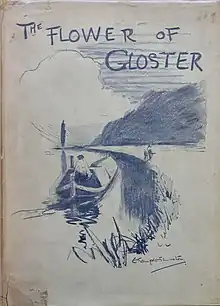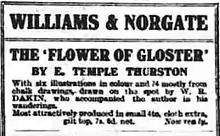 1st edition cover | |
| Author | E. Temple Thurston |
|---|---|
| Illustrator | W.R. Dakin et al |
| Subject | Canal Life |
| Genre | Travel |
| Set in | England |
| Publisher | Williams & Norgate, Chapman & Hall et al |
Publication date | 1911 |
| Preceded by | The Patchwork Papers |
| Followed by | The Open Window |
The Flower of Gloster is a 1911 book by E. Temple Thurston. Published by Williams and Norgate,[1] it sold well enough to merit a second edition two years later. A third unillustrated edition was published by Chapman and Hall in 1918, after which the book remained out of print for over half a century until being republished by David & Charles in 1968. A year before that, ITV had broadcast a 13-part children's serial of the same name loosely based on Thurston's original narrative.[2]
The book
Thurston's original book opens with the author dreaming of escape to the English countryside and trying to buy a narrowboat from which to see it. After meeting with scepticism and warnings about the unsavoury nature of canal people, he is advised to go to Oxford to view The Flower of Gloster. The boatyard owner, similarly sceptical, advises him to hire "some decent fellar with an horse, what'll look after yer going through the locks."[3] He introduces him to Eynsham Harry who, after some protracted negotiations in The Nag's Head, agrees to be Thurston's guide and mentor.[4]
Their journey takes them first along the Oxford Canal to just north of Banbury, where they join the sprawling network of Midlands canals. They head north through Warwick and Leamington Spa, but as they near the heavily industrialised landscape of the Black Country, Thurston begins to have some doubts about continuing and beseeches Eynsham Harry to turn the boat around and head back via the Stratford-upon-Avon Canal to the countryside.[4]
At one point in the journey, Thurston abandoned the canal in order to walk along the River Avon to Evesham and Tewkesbury, where he met up again with Eynsham Harry and The Flower of Gloster. According to David Viner's analysis of the text, the seemingly simple circuit of Oxford–Banbury–Warwick–Stratford–Tewkesbury–Oxford would not have been as straightforward as the author portrays it.[5] Viner questions whether the journey ever took place in its entirety or if the story was a composite of several journeys. Whatever the truth, Viner concluded that none of the doubts on the literal interpretation of the journey detract from the book's value as a 'good read', an example of Edwardian romanticism, or its influence on canal history which has now lasted over a century.[6]
| 1-21 | 22-41 |
|---|---|
| 1: The Discoverer | 22: Pour Passer Doucement Ma Vie |
| 2: Flower of Gloster | 23: Hedgerow Philosophy |
| 3: The Flower of Gloster (continued) | 24: Warwick |
| 4: Oxford | 25: The Gate into the Black Country |
| 5: Oxford (continued) | 26: The Stratford-on-Avon Canal |
| 6: Joseph Pipkin – Owner | 27: Lowson Ford |
| 7: The Bargain | 28: Yarningdale Farm |
| 8: The Beginning of the Journey | 29: The Compleat Angler |
| 9: John Aikin and Anna Laetitia | 30: Preston Bagot |
| 10: Why I Would Like it to have been Anna Laetitia | 31:A Cure for Trippers |
| 11: Shipton-on-Cherwell | 32: An Old Nunnery |
| 12: Shipton-on-Cherwell (continued) | 33: Fladbury Mill |
| 13: Shipton-on-Cherwell (continued) | 34: Wool Gathering |
| 14: Somerton | 35: Apple Blossom |
| 15: The Trade in Old Bits | 36: Tewkesbury |
| 16: Cropredy | 37: The Golden Valley |
| 17: The First Patchwork Quilt – Cropredy | 38: The Golden Valley (continued) |
| 18: The Red Lion – Cropredy | 39: Hard Boiled Eggs |
| 19: The History of Cropredy | 40: Dietetics |
| 20: The Spare Bootlace | 41: The Last Lock |
| 21: School Days |
| Date | Publisher | Notes |
|---|---|---|
| 1911 | Williams and Norgate | First Edition. Illustrated by W.R. Dakin. |
| 1912 | Dodd, Mead &Co. | US edition. Illustrated by W.R. Dakin. |
| 1913 | Williams and Norgate | 2nd Edition. Illustrated by W.R. Dakin. |
| 1918 | Chapman and Hall | 3rd Edition. Unillustrated. |
| 1968 | David & Charles | 4th Edition. Illustrated with Thurston's original photos. |
| 1970 | Rupert Hart-Davis | Bill Grundy, TV tie-in. Illustrated with stills from the TV serial. |
| 1972 | David & Charles | 5th Edition. Illustrated with Thurston's original photos. |
| 1984 | Alan Sutton Publishing | 6th Edition. Illustrated with Thurston's original photos and contemporary sources. With an introduction and commentary by museums and archaeology consultant David Viner. |
| 2004 | Ronald Crowhurst | In The Wake of The Flower of Gloster: A Reconstruction of Temple Thurston's Historic Canal Journey of 1911, is a large-format photo book by Scottish art historian John Kemplay.[7] |

Influence
Setting down his own experiences thirty years later in his book Narrow Boat, historian L.T.C. Rolt referred to The Flower of Gloster with delight, saying that it held pride of place in his own tiny collection of canal literature, the only professional account to have appeared in the previous fifty years.[8]
Illustrations
The 1911 edition of Flower of Gloster included six watercolour scenes and numerous line drawings, all by Scottish artist W.R. Dakin and based on the author's photographs. The illustrations appear to have been a large part of the book's appeal, and in its review of 'a delightful book' The Westminster Gazette said that the illustrations were 'among the sincerest, most spontaneous and charming ever seen in modern books'.[9] The Scotsman's reviewer noted that the book's value was heightened by 'the excellent sketches by W.R. Dakin in black and white and colours'.[10] Dakin was a contributor to The Bookman, a monthly review magazine. As editor of the 1968 David & Charles edition, L.T.C. Rolt dropped Dakin's watercolours in favour of eight of Temple Thurston's original photographs. The photographs were kept for the 1984 book, mixed in with many more contemporary photographs which editor David Viner thought gave Temple Thurston's account a 'period feel' as it was a time of great activity for photographers recording social life and customs for use as postcards.[11]
American edition
An American edition was published by Dodd, Mead and Company in 1912. The US version was identical to the first British editions apart from the original ‘Art Deco’ cover, which was changed to include an illustration of a boat more in tune with the American concept of a canal barge
TV serial
In 1967, Granada TV broadcast a 13-part children's serial called The Flower of Gloster, loosely based on Thurston's original. When their boatyard owner father is taken ill, his eldest son Dick, accompanied by siblings 10-year-old Michael and 12-year-old Elizabeth, volunteers to deliver a narrow-boat – The Flower of Gloster - to a buyer on his behalf. During their 220-mile trip south they make new friends, face dangers and difficulties, played out against the changing patterns of the British countryside. Their course winds its way from Wales, through the inland waterways of England to the Pool of London at Tower Bridge.
It was the first Granada TV series to be filmed in colour (though initially transmitted in black and white). Professional actors Richard O'Callaghan and Annette Robertson, were cast alongside real-life siblings Elizabeth and Mike Doherty playing the younger children. Also appearing were many of the real-life canal folk, by then an almost extinct as a breed.
The TV serial was followed a few years later by a book of the same name, authored by the producer Bill Grundy.[12] Grundy intended the series to be educational as much as adventure, with information about geology and wildlife. He claimed to have got the idea after visiting a rally near his home in Marple.[13]
List of Episodes
| No. | Title | Original air date |
|---|---|---|
| 1 | "The Accident" | 27 September 1967 |
| 2 | "The Cut" | 4 October 1967 |
| 3 | "The Boy" | 11 October 1967 |
| 4 | "The Girl" | 18 October 1967 |
| 5 | "Betton Woods" | 25 October 1967 |
| 6 | "The Dog" | 1 November 1967 |
| 7 | "Lost!" | 8 November 1967 |
| 8 | "The City" | 15 November 1967 |
| 9 | "Life and Death" | 22 November 1967 |
| 10 | "The Tunnel" | 29 November 1967 |
| 11 | "The Deadline" | 6 December 1967 |
| 12 | "The Hitch" | 13 December 1967 |
| 13 | "Late!" | 20 December 1967 |
References
- ↑ "The "Flower of Gloster"". Display Advertising. The Times. No. 39721. London. 20 October 1911. p. 8. Retrieved 15 December 2016.
- ↑ "Television and radio programmes". Arts and Entertainment. The Times. No. 57057. London. 27 September 1967. p. 14. Retrieved 15 December 2016.
- ↑ Temple Thurston, E. (1968). "Chapter 6". The Flower of Gloster. Newton Abbot, David & Charles.
- 1 2 Thurston, E Temple (1968). The Flower of Gloster. Newton Abbot, David & Charles.
- ↑ Temple Thurston, E. (1984). "Introduction". In Viner, David (ed.). The Flower of Gloster.
- ↑ The Flower of Gloster (illustrated edition), Viner, David, Alan Sutton Publishing, 1984
- ↑ The Herald, 19 November 1991, John Kemplay interviewed
- ↑ Narrow Boat, Rolt, L.T.C., Eyre & Spottiswoode, 1944
- ↑ The Westminster Gazette, 1911 (exact date unknown)
- ↑ The Scotsman, 26 October 1911
- ↑ Temple Thurston, E. (1984). "Commentary to the Illustrations". In Viner, David (ed.). The Flower of Gloster.
- ↑ The Flower of Gloster. Grundy, Bill, Rupert Hart-Davis Ltd, London, 1970.
- ↑ Interview with Bill Grundy, TV Times, 23–29 September 1967.
External links
- The Flower of Gloster at IMDb
- The Flower of Gloster at Nostalgia Central